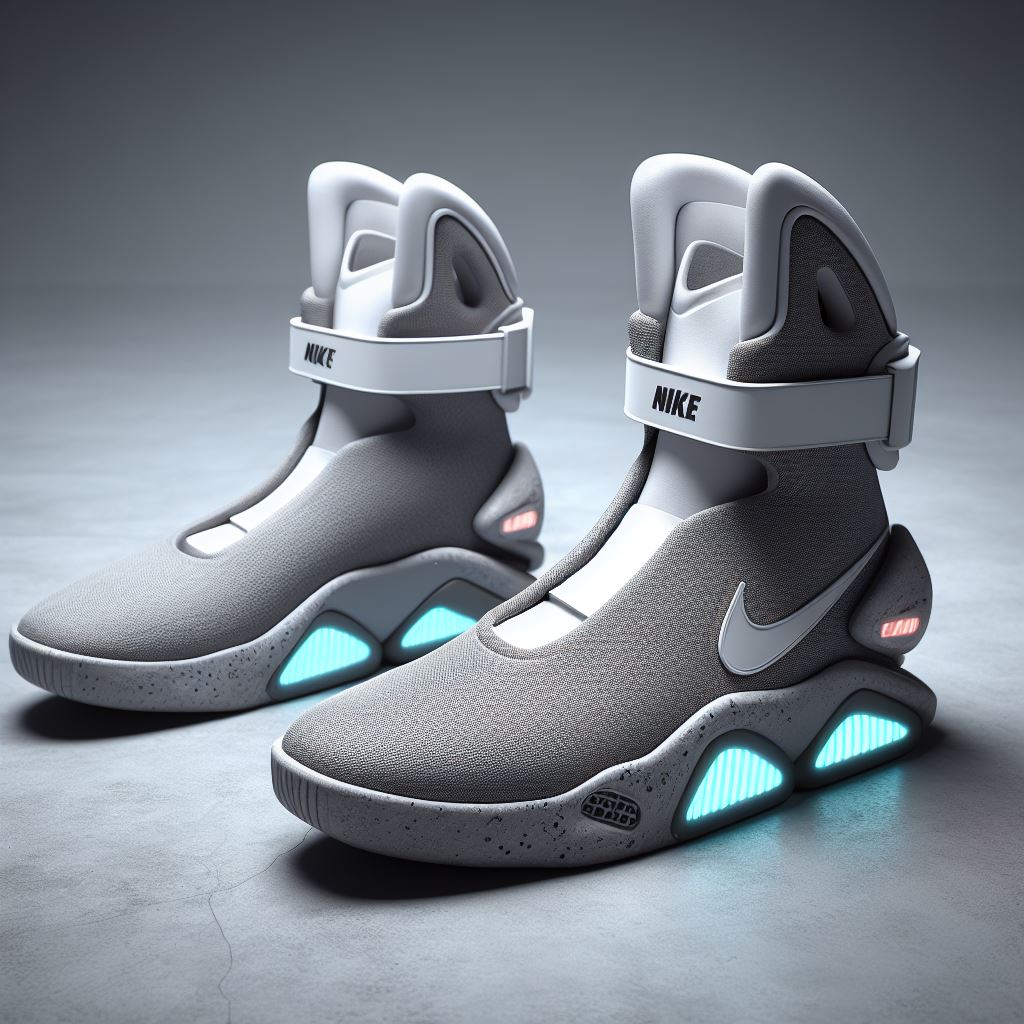The Magic Behind Self-Lacing Technology
Nike’s self-lacing shoes, often referred to as “adaptive fit” technology, represent a significant leap in footwear innovation. At the heart of this technology is a small motor and gear train, which tightens or loosens the shoe based on user preferences. The system is powered by a rechargeable battery, ensuring wearers can enjoy the self-lacing experience throughout the day. With a simple touch or through a dedicated app, users can adjust the fit, making it tighter for athletic activities or looser for casual wear.
Delving Deeper into Self-Lacing Technology
Nike’s self-lacing, or “adaptive fit” technology, is a marvel that seamlessly blends engineering and design. Here’s a closer look at the intricate workings of this groundbreaking feature:
Mechanism and Functionality
At the core of the self-lacing system is a tiny, yet powerful motor housed within the shoe’s sole. This motor is connected to a series of intricate pulleys and cables that run through the shoe’s upper. When activated, the motor either winds or unwinds these cables, causing the shoe to tighten or loosen respectively.
User Interface and Control
Nike’s self-lacing shoes come equipped with physical buttons located on the shoe’s side, allowing wearers to manually adjust the fit. However, the true magic lies in the ability to control the shoes via a dedicated smartphone app. This app not only lets users adjust the tightness but also offers preset modes for different activities, from running to relaxation.
Battery and Charging
Powering the self-lacing mechanism is a rechargeable lithium-polymer battery. A single charge can last anywhere from 10 to 20 days, depending on usage. The shoes come with a wireless charging pad, making the charging process as futuristic as the shoes themselves.
Sensors and Adaptability
What sets Nike’s self-lacing shoes apart is their ability to “learn” and “adapt.” Integrated sensors within the shoe can detect the foot’s contours and pressure points. Over time, the system understands the wearer’s preferred fit and can automatically adjust to those specifications when worn.
Durability and Reliability
Given the mechanical nature of the self-lacing system, durability is paramount. Nike has rigorously tested the technology to ensure it withstands various conditions, from wet weather to intense physical activity. The result is a shoe that’s not only technologically advanced but also reliable and long-lasting.
In essence, Nike’s self-lacing technology is a testament to the brand’s commitment to innovation. It’s a perfect blend of form and function, offering wearers an unparalleled footwear experience.
From Silver Screen to Reality
The concept of self-lacing shoes might seem like a futuristic idea, but its roots trace back to popular culture, particularly the silver screen. Let’s embark on a journey to discover how a cinematic fantasy became a tangible reality.
The “Back to the Future” Inspiration
The world first glimpsed the idea of self-lacing shoes in the 1989 film “Back to the Future Part II.” Marty McFly, played by Michael J. Fox, dons a pair of Nike MAGs that automatically adjust to his feet. This iconic scene not only captured the imagination of moviegoers but also set the wheels in motion for real-world innovation.
Nike’s Visionary Approach
Intrigued by the cinematic concept, Nike saw the potential to turn fiction into reality. Tinker Hatfield, the legendary Nike designer, took on the challenge. He believed that the technology could revolutionize athletic footwear, offering athletes a shoe that could adapt to their unique foot shape and movement.
Years of Research and Development
Turning the idea into a functional product wasn’t an overnight task. It took years of research, experimentation, and countless prototypes. Nike collaborated with engineers, designers, and tech experts to refine the technology, ensuring it was both practical and user-friendly.
The 2016 Breakthrough
In 2016, the dream became a reality. Nike introduced the HyperAdapt 1.0, the world’s first commercially available self-lacing shoe. While it drew inspiration from the movie, the shoe was designed with real-world applications in mind, catering to athletes and tech enthusiasts alike.
Public Reception and Legacy
The release of the HyperAdapt 1.0 was met with widespread acclaim. Fans marveled at the shoe’s blend of style and cutting-edge technology. Since then, Nike has continued to refine and expand its self-lacing lineup, solidifying its position as a pioneer in footwear innovation.
In conclusion, the journey of Nike’s self-lacing shoes is a testament to the power of imagination and innovation. What began as a cinematic dream has transformed the landscape of athletic footwear, proving that the future, sometimes, isn’t as far off as it seems.
The Evolution of Nike’s Self-Lacing Lineup
Nike’s journey into the realm of self-lacing shoes has been nothing short of revolutionary. From its initial concept inspired by a movie to its current state-of-the-art designs, the evolution of this technology showcases Nike’s commitment to pushing boundaries. Let’s delve into the progression of this iconic lineup.
The Nike MAG: The Prototype
The Nike MAG, inspired by “Back to the Future Part II,” was the first step. Released in limited quantities in 2011 for charity, it captured the essence of the movie’s design but lacked the self-lacing feature. However, it set the stage for what was to come.
HyperAdapt 1.0: The First Commercial Release
In 2016, Nike made a significant leap with the introduction of the HyperAdapt 1.0. It was the world’s first commercially available shoe with adaptive lacing. Using sensors, the shoe detected the foot’s contours and adjusted the laces accordingly, offering a personalized fit.
Adapt BB: Bridging Tech and Basketball
2019 saw the release of the Nike Adapt BB, a basketball shoe that integrated the self-lacing technology. Designed for performance, it allowed athletes to adjust the fit via a smartphone app, ensuring optimal comfort and support on the court.
Expanding the Adapt Series
Following the success of the Adapt BB, Nike expanded the Adapt series to cater to various sports, including running and training. Each iteration brought refinements, enhancing battery life, responsiveness, and the overall user experience.
The Future: Beyond Lacing
While self-lacing remains a core feature, Nike’s vision for the future encompasses more than just that. Recent patents suggest the integration of health monitoring features, real-time feedback mechanisms, and even temperature control functionalities.
In essence, Nike’s self-lacing lineup has evolved from a cinematic fantasy to a series of shoes that not only adapt to the wearer’s foot but also aim to enhance the overall athletic experience. With continuous innovation, the future of Nike’s self-lacing shoes promises to be even more exciting and groundbreaking.
Self-Lacing Shoes in Pop Culture
Nike’s self-lacing shoes have not only been a technological marvel but also a significant cultural phenomenon. Here are some notable moments:
| Moment | Description |
|---|---|
| Back to the Future Part II (1989) | The movie that introduced the concept of self-lacing shoes, with Marty McFly donning a pair of Nike MAGs. |
| HyperAdapt 1.0 Release (2016) | Nike’s first commercial self-lacing shoe, drawing massive media attention and fan excitement. |
| NBA Players Wearing Adapt BB (2019) | Several NBA players, including Jayson Tatum, showcased the Adapt BB on the court, highlighting its athletic potential. |
| Celebrities Embracing the Tech | From sneakerheads to A-list celebrities, many have been spotted wearing Nike’s self-lacing shoes, further cementing their cultural significance. |
| Tech Reviews & Unboxings | Numerous tech and sneaker reviewers have featured the shoes, emphasizing their innovative nature and design. |
Sustainability and Innovation: Walking Hand in Hand
Nike, as a global sportswear giant, has always been at the forefront of innovation. But in recent years, the brand has taken significant strides to ensure that its technological advancements also align with sustainable practices. When it comes to the self-lacing shoes, this commitment to sustainability and innovation becomes even more evident.
Material Choices
One of the primary ways Nike integrates sustainability into its self-lacing lineup is through the careful selection of materials. The brand has been progressively using recycled materials, such as recycled polyester, to craft significant portions of the shoe. This not only reduces waste but also diminishes the carbon footprint associated with the production process.
Energy Efficiency
The self-lacing mechanism, being electronic, requires power. Nike has been keen on ensuring that the energy consumption of this technology is minimal. Moreover, the charging solutions provided are designed to be energy efficient, ensuring that the environmental impact is as low as possible.
Longevity and Durability
A sustainable product is one that lasts. By investing in high-quality materials and advanced design techniques, Nike ensures that its self-lacing shoes have a prolonged lifespan. This reduces the frequency of replacements, leading to decreased consumption and waste in the long run.
Circular Design Philosophy
Nike has been vocal about its commitment to a circular economy. This means designing products that can be easily recycled or repurposed at the end of their life cycle. The self-lacing shoes, with their modular components, align well with this philosophy, allowing for easier recycling and reducing landfill waste.
Collaborative Efforts for a Greener Future
Recognizing the power of collaboration, Nike has partnered with various organizations and tech companies to further its sustainable innovation. These collaborations aim to find greener alternatives for materials, more energy-efficient tech solutions, and overall better manufacturing practices.
In conclusion, Nike’s journey with self-lacing shoes isn’t just about futuristic technology; it’s also a testament to the brand’s dedication to marrying innovation with sustainability. As consumers become more eco-conscious, Nike’s efforts in this direction not only cater to market demands but also set a precedent for other brands in the industry.
What’s Next for Nike’s Self-Lacing Tech?
The future looks bright for Nike’s adaptive fit technology. As the tech becomes more refined, we can expect to see self-lacing features in a broader range of shoes, from running to casual wear. Additionally, as wearable tech becomes more integrated into our daily lives, the potential for shoes that can sync with other devices and offer health insights is on the horizon.
In Conclusion
Nike’s self-lacing shoes are more than just a cool gadget; they represent the brand’s vision for the future of footwear. As technology and fashion continue to intertwine, it’s exciting to think about what innovations lie ahead. Want to stay updated on the latest in footwear tech? Make sure to check out our blog regularly and share this article with fellow sneaker enthusiasts!

